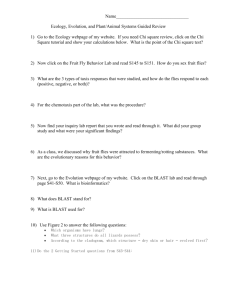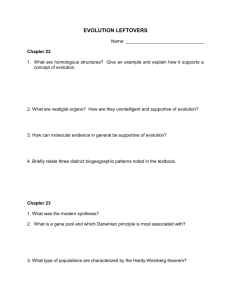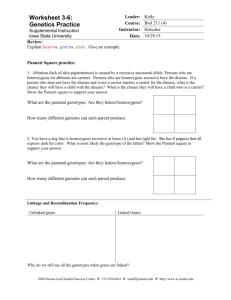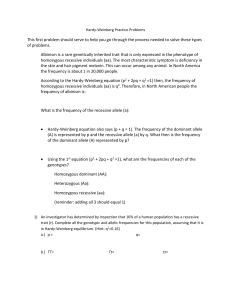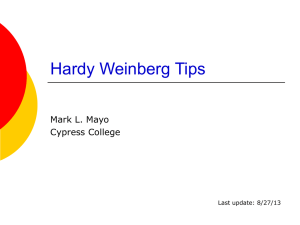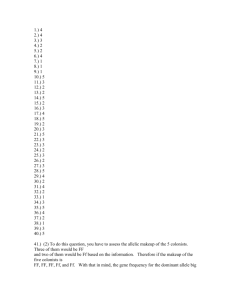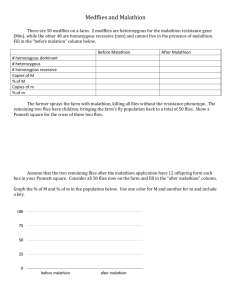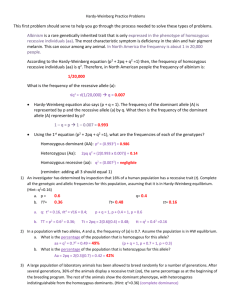Ecology, Evolution, and Plant/Animal Systems Guided Review
advertisement
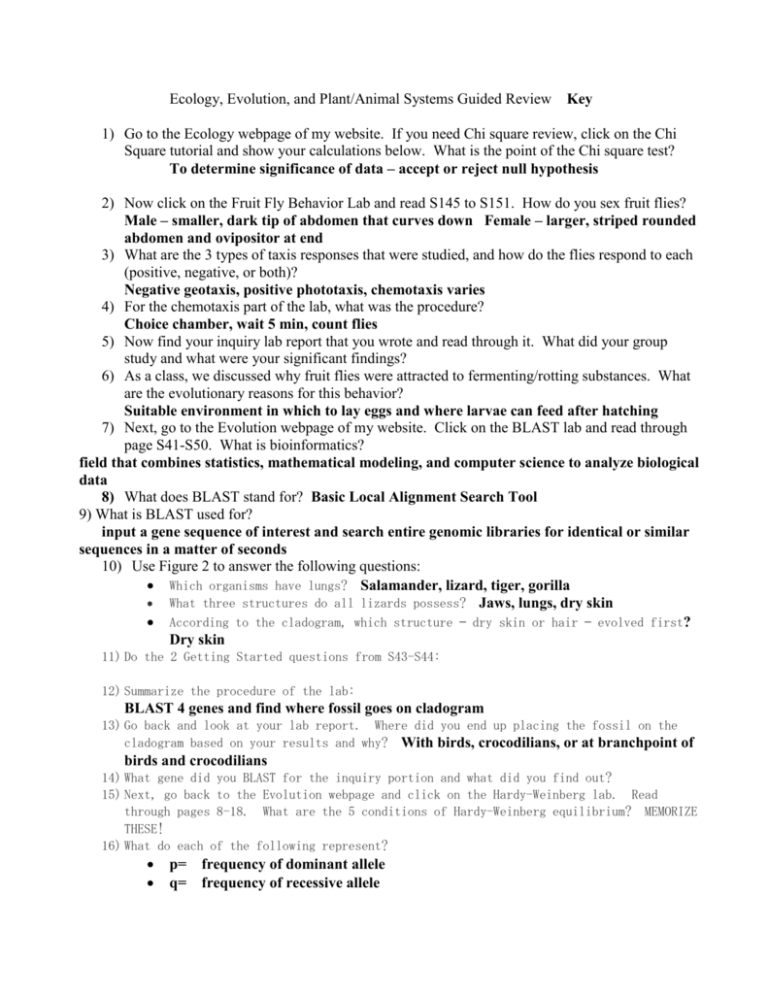
Ecology, Evolution, and Plant/Animal Systems Guided Review Key 1) Go to the Ecology webpage of my website. If you need Chi square review, click on the Chi Square tutorial and show your calculations below. What is the point of the Chi square test? To determine significance of data – accept or reject null hypothesis 2) Now click on the Fruit Fly Behavior Lab and read S145 to S151. How do you sex fruit flies? Male – smaller, dark tip of abdomen that curves down Female – larger, striped rounded abdomen and ovipositor at end 3) What are the 3 types of taxis responses that were studied, and how do the flies respond to each (positive, negative, or both)? Negative geotaxis, positive phototaxis, chemotaxis varies 4) For the chemotaxis part of the lab, what was the procedure? Choice chamber, wait 5 min, count flies 5) Now find your inquiry lab report that you wrote and read through it. What did your group study and what were your significant findings? 6) As a class, we discussed why fruit flies were attracted to fermenting/rotting substances. What are the evolutionary reasons for this behavior? Suitable environment in which to lay eggs and where larvae can feed after hatching 7) Next, go to the Evolution webpage of my website. Click on the BLAST lab and read through page S41-S50. What is bioinformatics? field that combines statistics, mathematical modeling, and computer science to analyze biological data 8) What does BLAST stand for? Basic Local Alignment Search Tool 9) What is BLAST used for? input a gene sequence of interest and search entire genomic libraries for identical or similar sequences in a matter of seconds 10) Use Figure 2 to answer the following questions: Which organisms have lungs? Salamander, lizard, tiger, gorilla What three structures do all lizards possess? Jaws, lungs, dry skin According to the cladogram, which structure — dry skin or hair — evolved first? Dry skin 11) Do the 2 Getting Started questions from S43-S44: 12) Summarize the procedure of the lab: BLAST 4 genes and find where fossil goes on cladogram 13) Go back and look at your lab report. Where did you end up placing the fossil on the cladogram based on your results and why? With birds, crocodilians, or at branchpoint of birds and crocodilians 14) What gene did you BLAST for the inquiry portion and what did you find out? 15) Next, go back to the Evolution webpage and click on the Hardy-Weinberg lab. Read through pages 8-18. What are the 5 conditions of Hardy-Weinberg equilibrium? MEMORIZE THESE! 16) What do each of the following represent? p= q= frequency of dominant allele frequency of recessive allele p2= frequency of homozygous dominant phenotype individuals q2= frequency of homozygous recessive phenotype individuals 2pq= frequency of heterozygous phenotype individuals 17) Which of the above do you have to know to calculate everything else? q 18) What are the 2 equations you use to solve any Hardy-Weinberg question? P+q=1 and p2+2pq+q2=1 19) Summarize the procedure for each part of the lab, including what each scenario represents: 8A – tasters in class 8B – Hardy Weinberg equilibrium 8C – Selection against homozygous recessive 8D – Heterozygous advantage 8E – Genetic drift 20) Pick a couple of the questions on pg. 18 to redo below, then find your original lab and check your answers. You may want to also find your Hardy-Weinberg quiz and go over that. 21) Next, go to the Plant and Animal Systems webpage on my website. Click on the Transpiration Virtual Lab. Go through the lab until you get to the test yourself page. Do the 3 questions and check your answers: 1) 2) 3) 22) How do guard cells function? 23) What is the equation for photosynthesis? 24) Do the 4 questions on factors that affect the rate of transpiration and check your answers: 1) 2) 3) 4) 25) Summarize the design of the experiment, including the different experimental groups: 26) Why do you have to calculate leaf surface area? 27) Analysis of Results I – Calculate the rate of water loss in ml/m2/min (most righthand column): Room – Light – Fan – Mist – 28) Put the above in order from highest rate of water loss to lowest and explain why: 29) Do Lab Quiz 1 below and correct your answers: 1) 2) 3) 4) 5) 6) 7) 8)
